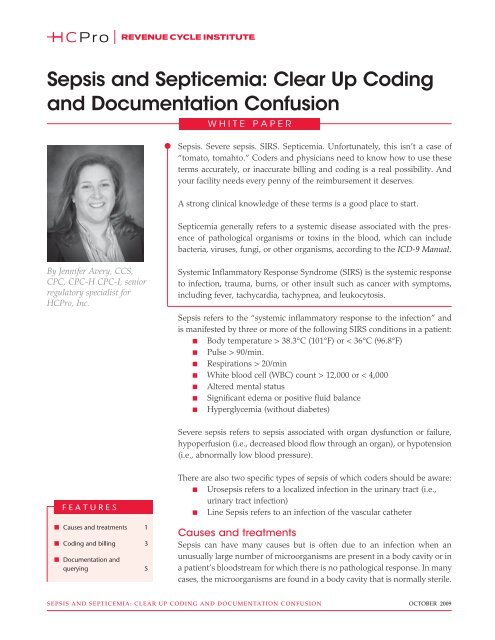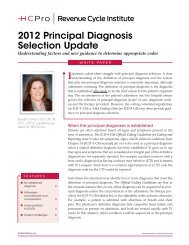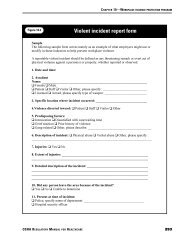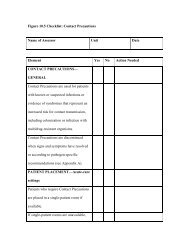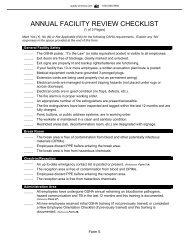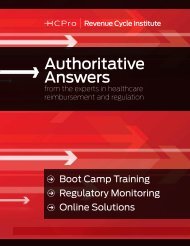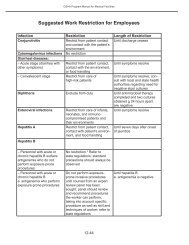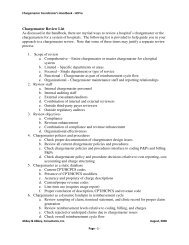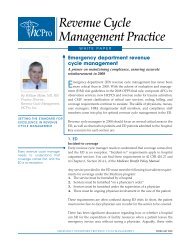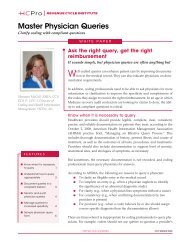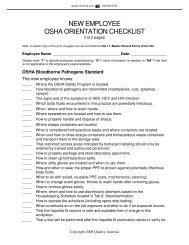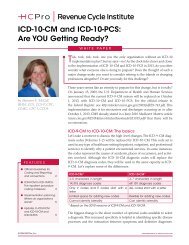Sepsis and Septicemia: Clear Up Coding and ... - HCPro Blogs
Sepsis and Septicemia: Clear Up Coding and ... - HCPro Blogs
Sepsis and Septicemia: Clear Up Coding and ... - HCPro Blogs
You also want an ePaper? Increase the reach of your titles
YUMPU automatically turns print PDFs into web optimized ePapers that Google loves.
<strong>Sepsis</strong> <strong>and</strong> <strong>Septicemia</strong>: <strong>Clear</strong> <strong>Up</strong> <strong>Coding</strong><br />
<strong>and</strong> Documentation Confusion<br />
W h i t e p a p e r<br />
<strong>Sepsis</strong>. Severe sepsis. SIRS. <strong>Septicemia</strong>. Unfortunately, this isn’t a case of<br />
“tomato, tomahto.” Coders <strong>and</strong> physicians need to know how to use these<br />
terms accurately, or inaccurate billing <strong>and</strong> coding is a real possibility. And<br />
your facility needs every penny of the reimbursement it deserves.<br />
A strong clinical knowledge of these terms is a good place to start.<br />
<strong>Septicemia</strong> generally refers to a systemic disease associated with the presence<br />
of pathological organisms or toxins in the blood, which can include<br />
bacteria, viruses, fungi, or other organisms, according to the ICD-9 Manual.<br />
By Jennifer Avery, CCS,<br />
CPC, CPC-H CPC-I, senior<br />
regulatory specialist for<br />
<strong>HCPro</strong>, Inc.<br />
Systemic Inflammatory Response Syndrome (SIRS) is the systemic response<br />
to infection, trauma, burns, or other insult such as cancer with symptoms,<br />
including fever, tachycardia, tachypnea, <strong>and</strong> leukocytosis.<br />
<strong>Sepsis</strong> refers to the “systemic inflammatory response to the infection” <strong>and</strong><br />
is manifested by three or more of the following SIRS conditions in a patient:<br />
■■<br />
Body temperature > 38.3°C (101°F) or < 36°C (96.8°F)<br />
■■<br />
Pulse > 90/min.<br />
■■<br />
Respirations > 20/min<br />
■■<br />
White blood cell (WBC) count > 12,000 or < 4,000<br />
■■<br />
Altered mental status<br />
■■<br />
Significant edema or positive fluid balance<br />
■■<br />
Hyperglycemia (without diabetes)<br />
Severe sepsis refers to sepsis associated with organ dysfunction or failure,<br />
hypoperfusion (i.e., decreased blood flow through an organ), or hypotension<br />
(i.e., abnormally low blood pressure).<br />
F E A T U R E S<br />
■■<br />
Causes <strong>and</strong> treatments 1<br />
■■<br />
<strong>Coding</strong> <strong>and</strong> billing 3<br />
■■<br />
Documentation <strong>and</strong><br />
querying 5<br />
There are also two specific types of sepsis of which coders should be aware:<br />
■■<br />
Urosepsis refers to a localized infection in the urinary tract (i.e.,<br />
urinary tract infection)<br />
■■<br />
Line <strong>Sepsis</strong> refers to an infection of the vascular catheter<br />
Causes <strong>and</strong> treatments<br />
<strong>Sepsis</strong> can have many causes but is often due to an infection when an<br />
unusually large number of microorganisms are present in a body cavity or in<br />
a patient’s bloodstream for which there is no pathological response. In many<br />
cases, the microorganisms are found in a body cavity that is normally sterile.<br />
<strong>Sepsis</strong> <strong>and</strong> <strong>Septicemia</strong>: <strong>Clear</strong> up <strong>Coding</strong> <strong>and</strong> Documentation Confusion octoBER 2009
2 Present on Admission: Accurate reporting to ensure appropriate reimbursement October 2009<br />
For example, bacteremia, which refers to the laboratory finding of bacteria<br />
in the bloodstream through a positive blood culture only, can progress to<br />
septicemia. But note that bacteremia denotes a laboratory finding, whereas<br />
septicemia denotes acute illness. Bacteremia progresses to septicemia only<br />
when there is a more severe infectious process or an impaired immune system.<br />
Coders should be aware of the difference between these two conditions<br />
<strong>and</strong> consult the physician when the diagnosis is not clearly differentiated,<br />
according to the <strong>Coding</strong> Clinic, Volume 17, Number 2, second quarter 2000.<br />
Negative or inconclusive blood cultures do not preclude a diagnosis of septicemia<br />
or sepsis in patients with clinical evidence of the condition. Prior use<br />
of antibiotics by the patient or technical issues surrounding blood sampling<br />
can sometimes lead to a negative or inconclusive result. In fact, only 28% of<br />
patients with sepsis have positive blood cultures, according to a recent study<br />
of eight academic medical centers.<br />
Negative or inconclusive<br />
blood cultures do not<br />
preclude a diagnosis<br />
of septicemia or sepsis<br />
in patients with clinical<br />
evidence of the condition.<br />
Other causes of local inflammation, characterized by redness <strong>and</strong> inflammation,<br />
include:<br />
■■<br />
Surgical wounds<br />
■■<br />
Endocarditis<br />
■■<br />
Cellulitis<br />
■■<br />
Burns<br />
■■<br />
Trauma<br />
Coders <strong>and</strong> physicians commonly overlook these causes of septicemia. In<br />
these cases, toxins can be released from the localized inflammation into tissues<br />
leading to septicemia.<br />
<strong>Sepsis</strong> can lead to septic shock or organ dysfunction or failure without<br />
treatment.<br />
Septic shock is a sudden disturbance of mental or physical equilibrium <strong>and</strong><br />
is a condition of hemodynamic <strong>and</strong> metabolic disturbance marked by the<br />
circulatory system’s failure to maintain adequate blood flow to vital organs.<br />
Inadequate blood volume (i.e., hypovolemic shock) may cause septic shock,<br />
as can inadequate cardiac function (i.e., cardiogenic shock) or inadequate<br />
vasomotor function (i.e., neurogenic shock).<br />
Signs of organ dysfunction or failure include the following:<br />
■■<br />
CV-shock: Systolic blood pressure < 90 or mean arterial pressure<br />
< 70 for at least one hour despite adequate fluid resuscitation.<br />
Vasopressor use may mask hypotension.<br />
■■<br />
Lactic (metabolic) acidosis: pH < 7.3 <strong>and</strong> plasma lactate > 1.5<br />
times normal.<br />
■■<br />
■■<br />
Renal: Urine output < 0.5 cc/kg/hr for one hour despite fluid<br />
resuscitation or Serum Cr > 0.5 mg/dl.<br />
Respiratory: PaO2/FiO2 ratio < 300 (nl wedge); hypoxemia<br />
© 2009 by <strong>HCPro</strong>, Inc. Any reproduction is strictly prohibited. For more information, call 877/233-8734 or visit www.revenuecycleinstitute.com.
October 2009 Present on Admission: Accurate reporting to ensure appropriate reimbursement 3<br />
■■<br />
■■<br />
■■<br />
Hematology: Plt. Ct. < 80,000 or 50% decrease over the past three<br />
days (thrombocytopenia); leukemoid or neutropenic reaction;<br />
protein C, D-dimer (hypercoaguable state), activated partial thromboplastin<br />
time (aPTT), prothrombin time (hypocoaguable state),<br />
hemolysis, anemia.<br />
Metabolic <strong>and</strong>/or septic encephalopathy: “Altered mental status”<br />
progressing to delirium <strong>and</strong> then coma, bilateral asterixis <strong>and</strong><br />
myoclonus, hypothermia, <strong>and</strong> other multiple abnormal signs of<br />
incomplete brain dysfunction.”<br />
Liver failure: Presence of metabolic encephalopathy in a patient<br />
with severe acute liver disease. Reflected by elevation of prothrombin<br />
time; other liver enzymes (bilirubin > 2.0, tranaminases 2 times<br />
normal) suggestive but not definitive.<br />
Treatment options for sepsis include:<br />
■■<br />
IV antibiotics<br />
■■<br />
Vasopressors<br />
■■<br />
Activated protein C (APC) (i.e., Xigris ® )<br />
■■<br />
Corticosteroids for glucose levels<br />
■■<br />
IV fluids<br />
■■<br />
Oxygen<br />
The medical <strong>and</strong> pharmacy<br />
communities carefully<br />
monitor the use of Xigris to<br />
treat severe sepsis.<br />
Xigris (i.e., drotrecogin alfa) (activated) is a new biological agent used to treat<br />
severe sepsis. It is a recombinant version of naturally occurring APC. APC<br />
ensures the control of inflammation <strong>and</strong> clotting in blood vessels. Patients<br />
with severe sepsis cannot convert protein C to the activated form in sufficient<br />
amounts. Drotrecogin alfa (activated) is thought to be able to bring<br />
blood clotting <strong>and</strong> inflammation back into balance <strong>and</strong> restore blood flow to<br />
the organs, according to the October 2002 <strong>Coding</strong> Clinic.<br />
The medical <strong>and</strong> pharmacy communities carefully monitor the use of Xigris<br />
to treat severe sepsis. Specific clinical indicators are required to be present<br />
(e.g., multiple system organ failure) to use it, <strong>and</strong> use is limited to infectious<br />
disease <strong>and</strong> pulmonary physicians treating patients with severe sepsis. The<br />
cost of this drug is approximately $7,000 per dose, according to the Xigris<br />
Web site (www.xigris.com).<br />
<strong>Coding</strong> <strong>and</strong> billing<br />
In general, coders may refer to their ICD-9 Manual for sepsis <strong>and</strong> septicemia<br />
coding guidance.<br />
When sepsis or severe sepsis is present on admission <strong>and</strong> meets the definition<br />
of principal diagnosis, the systemic infection code is the principal<br />
diagnosis (from category 038.xx). The fourth <strong>and</strong> fifth digits identify the<br />
specific causative organism. However, no additional organism code is necessary<br />
when a combination code exists to identify both the condition <strong>and</strong><br />
the cause.<br />
© 2009 by <strong>HCPro</strong>, Inc. Any reproduction is strictly prohibited. For more information, call 877/233-8734 or visit www.revenuecycleinstitute.com.
4 Present on Admission: Accurate reporting to ensure appropriate reimbursement October 2009<br />
<strong>Coding</strong> for SIRS, sepsis, <strong>and</strong> severe sepsis requires a minimum of two codes:<br />
A code for the underlying cause (such as infection or trauma) <strong>and</strong> a code<br />
from subcategory 995.9 (SIRS).<br />
The ICD-9 Manual tabular index states that coders should report the additional<br />
code 995.9 to identify SIRS, <strong>and</strong> the chapter-specific official coding<br />
guidelines further state that the physician must have documented either<br />
sepsis or SIRS to report the code. When the physician documentation merely<br />
states septicemia is present, it is inappropriate to report a code from subcategory<br />
995.9x without querying the physician.<br />
Coders can reflect the source of the infection by the use of codes within the<br />
995.9x subcategory when appropriate. Coders should report codes 995.91<br />
or 995.92 as an additional code to identify SIRS due to infectious process,<br />
depending on whether there is organ failure/dysfunction. Codes 995.93 <strong>and</strong><br />
995.94 are used to report SIRS due to noninfectious process (e.g., trauma,<br />
burns). Again, the decision regarding which of the two to report depends on<br />
the presence of organ failure or dysfunction. E codes are unnecessary with<br />
codes 995.91 <strong>and</strong> 995.92.<br />
Septic shock cannot occur<br />
in the absence of severe<br />
sepsis.<br />
If a patient admits for a localized infection <strong>and</strong> the sepsis, severe sepsis, or<br />
SIRS develops after admission, the localized infection would be the principal<br />
diagnosis with an additional code for sepsis, severe sepsis, <strong>and</strong> SIRS.<br />
When a physician documents septic shock, coders should report the systemic<br />
initiating infection first, then either code 995.92 or 995.94 <strong>and</strong> then<br />
785.52 for the septic shock. Coders must report the code from subcategory<br />
995.9x before the code for septic shock. Septic shock cannot occur in the<br />
absence of severe sepsis.<br />
For patients with severe sepsis with organ dysfunction or failure, coders<br />
must also remember to identify the specific organ dysfunction or failure (e.g.,<br />
renal or respiratory failure).<br />
Other code options to note include the following:<br />
■■<br />
Code 790.7 for bacteremia that is not further defined<br />
■■<br />
Code 799.89 for toxemia that is not further defined<br />
■■<br />
Code 599.0 for urosepsis that is not further defined<br />
■■<br />
Code 996.62 for line sepsis that is not further defined<br />
■■<br />
Code 771.81 for newborn sepsis<br />
Urosepsis is a nonspecific term. If it is the only term documented, coders<br />
should report code 599.0 based on the default for the term in the ICD-9<br />
Manual index. In addition, coders may report the code for the causal organism<br />
if known, according to the <strong>Coding</strong> Clinic, Volume 24, Number 4, fourth<br />
quarter 2007. Note also that a medical executive committee may not legislate<br />
that urosepsis means sepsis as a substitute for physician documentation per<br />
© 2009 by <strong>HCPro</strong>, Inc. Any reproduction is strictly prohibited. For more information, call 877/233-8734 or visit www.revenuecycleinstitute.com.
October 2009 Present on Admission: Accurate reporting to ensure appropriate reimbursement 5<br />
the <strong>Coding</strong> Clinic, second quarter 2004.<br />
Looking ahead, it is interesting to note that “septicemia” does not exist in<br />
the ICD-10 codes. When you reference it in ICD-10, it leads you to R78.81<br />
(bacteremia NOS). <strong>Sepsis</strong> codes have become more defined in ICD-10 <strong>and</strong><br />
documentation will be critical. For example, the term sepsis alone takes you<br />
to code A41.9 (other sepsis). However, depending on the modifying term,<br />
the code may change. For example, when the physician documents the<br />
causative organism, such as group B strep, the code changes to A40.1. Also,<br />
when the physician documents severe sepsis in ICD-10, it takes you to code<br />
R65.20 (severe sepsis without septic shock).<br />
Finally, it may be beneficial to note the following DRGs, which are relevant<br />
to sepsis coding <strong>and</strong> billing <strong>and</strong> are found within the major diagnostic category<br />
18, Infectious <strong>and</strong> Parasitic Diseases, Systemic or Unspecified Sites:<br />
■■<br />
■■<br />
■■<br />
DRG 870: <strong>Septicemia</strong> with mechanical ventilation 96+ hours<br />
DRG 871: <strong>Septicemia</strong> without mechanical ventilation 96+ hours<br />
with MCC<br />
DRG 872: <strong>Septicemia</strong> without mechanical ventilation 96+ hours<br />
without MCC<br />
Even when a patient meets<br />
the criteria for sepsis, if the<br />
documentation does not<br />
support how sick the patient<br />
is, auditors may question<br />
whether the sepsis codes<br />
were an appropriate choice.<br />
Documentation <strong>and</strong> querying<br />
Appropriate physician documentation is critical for coders <strong>and</strong> billers to<br />
accurately report sepsis <strong>and</strong> septicemia <strong>and</strong> to ensure that facilities receive<br />
the reimbursement to which they are entitled. Unfortunately, documentation<br />
requirements for these conditions aren’t necessarily easy to meet.<br />
For example, it doesn’t matter whether a patient meets the clinical criteria<br />
for having the conditions based on official coding guidelines, but that documentation<br />
supports how “sick” the patient was. For example, when the physician<br />
can demonstrate that the patient was admitted <strong>and</strong> was “very sick,”<br />
the coder can still use the physician’s supporting documentation to code for<br />
sepsis <strong>and</strong>/or SIRS even if the patient was able to get better in less time than<br />
what is usually considered an acceptable time frame for sepsis.<br />
However, the opposite can also hold true. Even when a patient meets the criteria<br />
for sepsis, if the documentation does not support how sick the patient is,<br />
auditors may question whether the sepsis codes were an appropriate choice.<br />
For a physician to validate that a patient “looks septic” or “looks sick,” the<br />
physician must communicate the relevant information in the history <strong>and</strong><br />
physical <strong>and</strong> progress notes. Information that the physician may include to<br />
support the diagnosis includes general variables such as the following:<br />
■■<br />
■■<br />
■■<br />
■■<br />
Fever (i.e., a core temperature higher than 38.3°C [101°F])<br />
Hypothermia (i.e., a core temperature lower than 36°C)<br />
Tachypnea<br />
Heart rate higher than 90 beats per minute or two st<strong>and</strong>ard devia-<br />
© 2009 by <strong>HCPro</strong>, Inc. Any reproduction is strictly prohibited. For more information, call 877/233-8734 or visit www.revenuecycleinstitute.com.
6 Present on Admission: Accurate reporting to ensure appropriate reimbursement October 2009<br />
■■<br />
■■<br />
■■<br />
tions (SD) above the normal for age<br />
Altered mental status<br />
Significant edema or positive fluid balance (i.e., 20 mL/kg over<br />
24 hrs)<br />
Hyperglycemia (i.e., plasma glucose higher than 120 mg/dL or<br />
7.7 mmol/L) in the absence of diabetes<br />
In addition, the physician should document any present inflammatory<br />
variables, such as:<br />
■■<br />
Leukocytosis (i.e., WBC count greater than 12,000/L)<br />
■■<br />
Leukopenia (i.e., WBC count less than 4,000/L)<br />
■■<br />
Greater than 10% immature forms<br />
––<br />
Includes “b<strong>and</strong>s,” “matamyelocytes,” “myelocytes”<br />
––<br />
Also known as “b<strong>and</strong>emia”—“left shift”<br />
■■<br />
Plasma C-reactive protein over two SD above the normal value<br />
■■<br />
Plasma procalcitonin over two SD above the normal value<br />
The physician should<br />
also be sure to note any<br />
variables present that may<br />
help qualify possible organ<br />
dysfunction.<br />
The physician should also be sure to note any variables present that may<br />
help qualify possible organ dysfunction:<br />
■■<br />
Arterial hypotension<br />
■■<br />
Systolic blood pressure less than 90 mm Hg<br />
■■<br />
Mean arterial pressure less than 70 mm Hg<br />
■■<br />
A systolic blood pressure decrease of greater than 40 mm Hg<br />
in adults or two SD below normal for the patient’s age<br />
■■<br />
SvO2 less than 70%<br />
■■<br />
Cardiac index greater than 3.5 L/min/M2<br />
This also includes other organ dysfunction variables. For example:<br />
■■<br />
Arterial hypoxemia (i.e., PaO2/FiO2 ratio less than 300)<br />
■■<br />
Acute oliguria (i.e., urine output less than 0.5 mL/kg*hr or<br />
45 mmol/L for at least two hours)<br />
■■<br />
Creatinine increase of 0.5 mg/dL<br />
––<br />
A definition of acute renal failure<br />
––<br />
Acute kidney injury (585.9) requires only 0.3 mg/dl rise<br />
■■<br />
Coagulation abnormalities (INR [international normalized ratio]<br />
> 1.5 or aPTT > 60 seconds)<br />
■■<br />
Ileus (i.e., absent bowel sounds)<br />
■■<br />
Thrombocytopenia (i.e., platelet count < 100,000/L)<br />
■■<br />
Hyperbilirubinemia (i.e., plasma total bilirubin > 4 mg/dL or<br />
70 mmol/L)<br />
The physician should also document any tissue perfusion variables that may<br />
be present, such as hyperlactatemia (i.e., over 1 mmol/L) or decreased capillary<br />
refill or mottling. Coders should also recognize that some physicians<br />
may underst<strong>and</strong> sepsis differently. For example, physicians who attended<br />
medical school 30 years ago may refer to a condition as “sepsis” or “sepsis<br />
syndrome,” but may actually be describing what is now known as “severe<br />
© 2009 by <strong>HCPro</strong>, Inc. Any reproduction is strictly prohibited. For more information, call 877/233-8734 or visit www.revenuecycleinstitute.com.
October 2009 Present on Admission: Accurate reporting to ensure appropriate reimbursement 7<br />
sepsis.” Similarly, some physicians mistakenly still underst<strong>and</strong> fever <strong>and</strong><br />
leukocytosis as inherent to the underlying cause of SIRS, instead of a manifestation<br />
of it. (And unfortunately, some commercial payers also struggle with<br />
these concepts.) Remind physicians who struggle with these terms that the<br />
Centers for Disease Control <strong>and</strong> Prevention classified sepsis in this manner.<br />
Coders should also<br />
recognize that some<br />
physicians may underst<strong>and</strong><br />
sepsis differently.<br />
The best offense when it comes to sepsis <strong>and</strong> documentation is physician<br />
education rather than the query process. However, realistically, queries will<br />
be necessary. Keep them clear <strong>and</strong> concise. State only the facts. And phrase<br />
the question with a multiple-choice format to respond, always including<br />
“other” as an option to use when the multiple-choice answers are incorrect<br />
for the case being queried.<br />
In many cases, coders are caught in the middle of a battle between the clinical<br />
<strong>and</strong> insurance worlds when it comes to this topic: The physician documenting<br />
sepsis means the coder codes the condition. But in recent years,<br />
that has not been enough documentation for insurance companies to accept<br />
the diagnosis. This is forcing coders into trying to ensure that the condition<br />
is supported by the documentation without questioning the physician’s<br />
clinical judgment. It comes down to physicians needing to underst<strong>and</strong> the<br />
importance of documentation that supports “how sick” the patient is in the<br />
absence of clinical data. n<br />
© 2009 by <strong>HCPro</strong>, Inc. Any reproduction is strictly prohibited. For more information, call 877/233-8734 or visit www.revenuecycleinstitute.com.
8 Present on Admission: Accurate reporting to ensure appropriate reimbursement October 2009<br />
10/09 SR5309<br />
© 2009 by <strong>HCPro</strong>, Inc. Any reproduction is strictly prohibited. For more information, call 877/233-8734 or visit www.revenuecycleinstitute.com.


